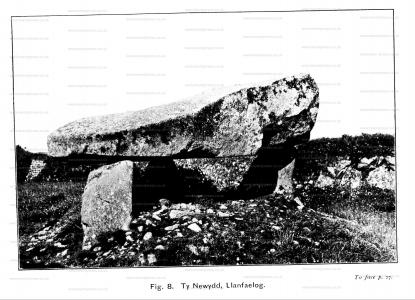Europe, British Isles, North-West Wales aka Gwynedd, Anglesey, Llanfaelog, Ty Newydd Burial Chamber [Map]
Ty Newydd Burial Chamber is in Llanfaelog, Anglesey, Prehistoric Anglesey Burial Chambers.
Ty Newydd Burial Chamber [Map]. Lay-by for two cars near to gate into field.
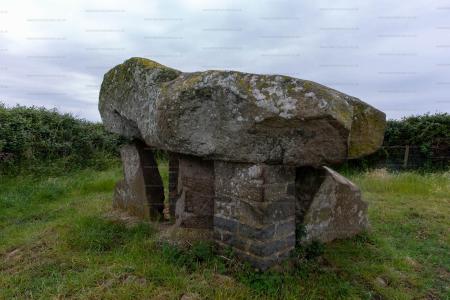
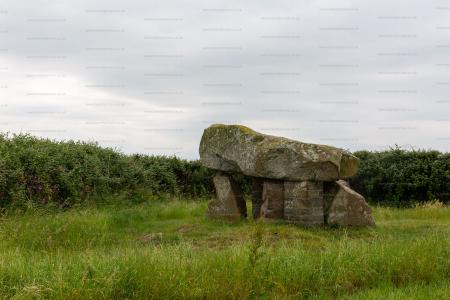
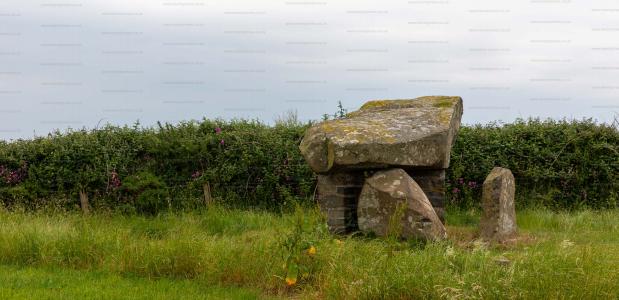
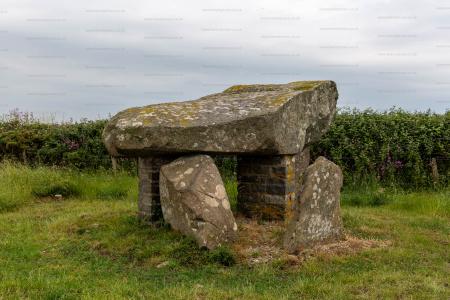
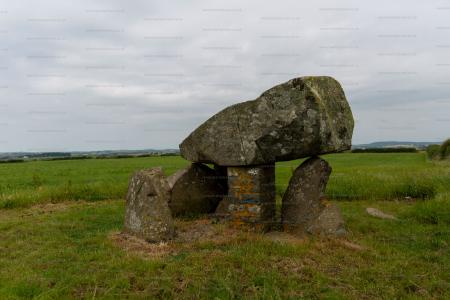
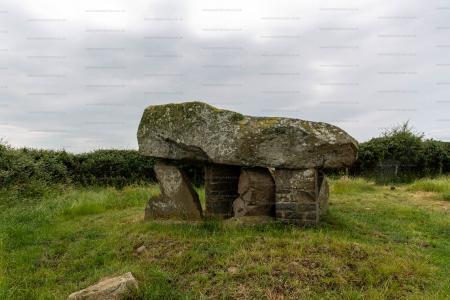
History of the Island of Mona. At Neuadd Llanvaelog resided Gryffydd ab Iorwerth Goch, (descended from Hwva ab Cyndelw) and his wife, Gwenllian, grand-daughter of Ririd Flaidd, to whose fostering care Edward I. confided Edward of Caernarvon. "Mamaeth Edward yr ail, oedd Wenllian, ac ar vroneu Sir Howel y Pedolau y macwyd ev. S. P. 495. Sic Per E. E. 40." And on a farm called "Ty Newydd," is a cromlech [Ty Newydd Burial Chamber [Map]]; the upper stone measures twelve feet long, quite bedded in the carnedd or heap of stones. — J. Lloyd."1 A modern tourist describes it thus, — "Not far from the church, on an elevated spot of ground, is a large cromlech, consisting of five upright stones, supporting a large stone, nearly in an horizontal position, about twelve feet long, beneath which is a small cell or cavity."
Caerwys MS.
Archaeological Journal Volume 3 Page 39. A remarkably fine remain of this nature is the cromlech at Llanfaelog [Map] of which we append a representation; the cromlech still standing is composed of one flat on several upright stones; the flat top being about 12ft. by 9ft. in breadth, and from 2 ft. to 3 ft. in thickness. By its side lie the fallen remains of a much larger cromlech, the upper stone of which is not less than 15 ft. in length; underneath the upright one are still to be seen numerous small stones, and the ground rises gently toward the upright supports on all sides; but on referring to Pennant, vol. ii. p. 238, we find him saying (in speaking of cromlechs) "others again are quite bedded in the Carnedd or heap of stones, of which instances may be produced in Llanfaelog, in this island, in that of Arran, and in the county of Meireonedd." If then this cromlech could have been so stripped of its covering since the end of the last century, what may we not expect to have taken place in other instances?
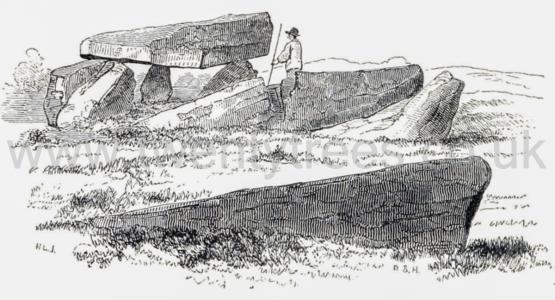
Archaeologia Cambrensis 1854 Page 205. A double Cromlech [Ty Newydd Burial Chamber [Map]],—Close to the house of Trefor, on the road from Beaumaris to Pentraeth, in a field on the south side of the road. They were erect not many years since, but were then thrown down by the tenant, because they were superstitious. (For "they were," read, "he was.")
A double Cromlech [Plas Newydd Burial Chamber [Map]],—In the park of Plas Newydd. This has been often engraved and described. (See Pennants' Tour in Wales; Journal of the Archaeological Institute, &c.) Traces of the carnedd of stones which once covered it are still visible.
Cromlech [Bryn Celli Ddu Burial Mound [Map]],—With passage of stones covered over, at Bryn Celli du, near Plas Newydd. This has been fully described and illustrated in the Archaologia Cambrensis? It is styled Yr Ogof, or the Cave, on the Ordnance map, from its having been always considered so until the superincumbent carnedd was removed. It is now securely fenced off, and preserved from future injury, by the care of C. Evans, Esq., of Plas Gwyn, acting on behalf of the Marquis of Anglesey. This is almost an unique instance of the kind in Wales.
Cromlech,—Near Llanidan Old Church, to the south-west ; it is partly thrown down. Cromlech,
At Bodowyr [Bodowyr Burial Chamber [Map]], near Llangaffo. This is one of the smallest cromlechau known, and is in admirable preservation. (See Journal of the British Archaeological Association.)
Archaeologia Cambrensis 1864 Page 44. Cromlech At Llanvaelog, Anglesey [Ty Newydd Burial Chamber [Map]].
Honourable Society of Cymmrodorion 1910. The dolmen at Ty Newydd [Map], in the parish of Llanfaelog, and three quarters of a mile N.E. of the Church, is supposed to have been formerly double, and it has been suggested that Pennant refers1 to this monument in his remarks on dolmens when he says: "Others again are quite bedded in the carnedd or heap of stones, of which instances may be produced in Llan Faelog It is noticed again in David Thomas' list and was visited by Skinner who calls it2 "a very perfect cromlech". The capstone was of an oblong shape and measured 16 ft. long, 6 ft. wide, and 3 ft. thick. It only rested upon three supporters, each about 3 ft. high, although there were four placed in the ground. Near the dolmen were lying two large stones, one of these being 17 ft. long and 3 ft. thick. Two good sketches accompany this account. Miss Llwyd, quoting from her father's MSS.3, says: "On a farm called Ty Newydd is a cromlech; the upper stone measures 12 ft. long, quite bedded in the carnedd or heap of stones". She adds, "a modern tourist describes it thus a large stone, nearly in a horizontal position, about 12 ft. long, beneath which is a small cell or cavity". Longueville Jones, writing in the Arch. Journ.4, describes it thus: "One flat on several upright stones, the flat top being about 12 ft. by 9 ft. in breadth and from 2 to 3 ft. in thickness. By its side lie the fallen remains of a much larger cromlech, the upper stone of which is not less than 15 ft. in length underneath the upright one are still to be seen numerous small stones, and the ground rises gently on all sides". A sketch accompanies this account. Writing in 18645, he again refers to the monuments and states that one cromlech was erect, and the other by the side of the first, having been thrown down or perhaps having formed part of a passage. The cap of the fallen one must have been 15 ft. long. The tenant of the farm had taken the stones for building, and at a later date a fire had been lit on the top of the cromlech to celebrate some event; this had split the stone, which at that time rested on three uprights.
Note 1. T. P., ii, p. 238.
Note 2. J.S. p. 46.
Note 3. A. Ld., p. 248.
Note 4. A. J., 1846, p. 42.
Note 5. A. C., 1864, p. 44.
